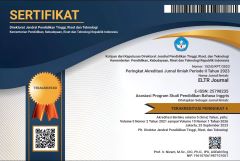THE COMMUNICATIVE PERSPECTIVE IN TRANSLATION STUDIES: A MOROCCAN UNIVERSITY CASE STUDY
Abstrak terlihat: 524 / PDF terunduh: 347DOI:
https://doi.org/10.37147/eltr.v5i1.101Keywords:
Translation studies, English Language Teaching, Intercultural Communication, Higher EducationAbstract
Translation of written texts has been a part of international communication for centuries, but courses in how to do it are more recent. This study reports a case study from the context of a Moroccan university where translation courses are taught in two parts. In one semester the students learn about translation from English to Arabic and the next from Arabic to English. We report the teachers’ perspectives on the translation course from Arabic into English, along with the results of the students’ translations based on 400 examination answers. The analysis and discussion of the results will reveal the shortcomings for the current teaching practice of translation; they will also suggest new ways of customizing the course for more effective acquisition of English language as a medium for boosting intercultural communication, the most probable prerequisite for today’s access in the job market.
Downloads
References
Alaoui A. (2013). The teaching of translation in Moroccan Universities. Retrieved from http://www.atida.org/english/index.php?option=com_content&view=article&id=34
Bassnett, S. (2000). Translation theory.
Byram, M. (2000). Routledge encyclopedia of language teaching and learning. London and New York: Routledge.
Catford, J. C. (1965). A linguistic theory of translation: An essay in applied linguistic. London: Oxford University Press.
El Karnichi,F. (2013). Issues in advanced translator training programmes at Moroccan Universities. ATIDA. http://www.atida.org/english/index.php?option=com_content&view=article&id=57
Groom, N., & Littlemore, J. (2011). Doing applied linguistics: A Guide for students. London and New York: Routledge.
Hall, C. J. S., Patrick, H., & Wicaksono, R. (2011). Mapping applied linguistics. London and New York: Routledge.
Hatim, & Mason. (1997). The translator as communicator. London: Routledge.
Hendzel, K. (2006). “Why do we need translators if we have dictionaries?” in E.M Rickerson
and Barry Hilton (eds) The 5-minute linguist. Sheffield U.K and Bristol USA.
Lasserre, B. (2018), Words that go “Ping”: The ridiculously wonderful world of ononmatopoeia. Sydney: Allen and Unwin.
Nida, E.A. (1964). Towards ascience of translating: With special reference to principles and procedures involved in bible translating. Leiden:Brill.
Nord, C. (1997). Translating as a purposeful activity: Functionalist approaches explained. Manchester: St Jerome Press.
Reiss, K. (2000). “Type, Kind and Individuality of Text: Decision Making In Translation”. Trans. S. Kitron In L. Venuti, ed. The Translation Studies Reader. London and New York: Routledge,
Rogers, M. (2000). “Translation” In Michael Byram (ed).
Toury, G. (1995). Descriptive translation studies and beyond. Amsterdam and Philadelphia: John Benjamins Publishing Company.
Downloads
Published
How to Cite
Issue
Section
License
Copyright (c) 2021 abdellah elboubekri, Marilyn Lewis

This work is licensed under a Creative Commons Attribution-ShareAlike 4.0 International License.













